Blueprints: Finishing Touches 30
[todo]
Golden – Altar (of Incense) 30:1-10
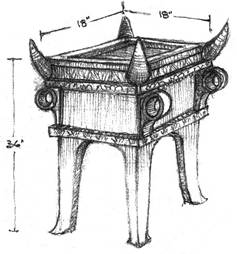
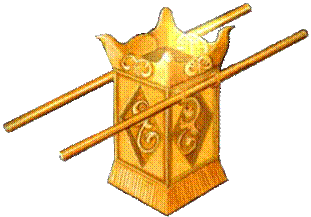
Silver – Atonement Fees 30:11-16
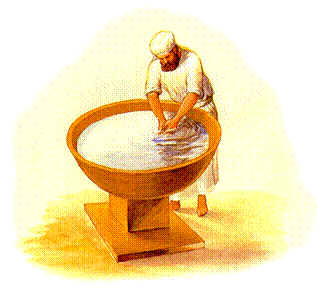 Bronze – Laver 30:17-21
Bronze – Laver 30:17-21
What’s a laver? A basin or bowl.
Why do some people call the Bronze laver a copper laver? Bronze is an alloy (that means it is made out of a combination of more than one metal) of primarily copper and one or more other metals such as tin or zinc.
“The priest must wash his hands and feet before he does any work in the tabernacle. Exodus 30:21 It symbolizes the necessity of purity in approaching God. The typology points to the washing of regeneration and sanctification in Christ. Titus 3:5; Hebrews 9:10” –David Graves
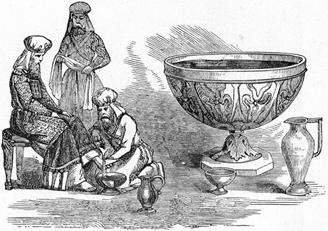
“Only the priests had access to the Laver, whereas the bronze altar was accessible to all.”
“At their consecration the priests were washed all over at the Laver before being clothed with priestly garments and anointed (Lev.29:4-7). They did not wash themselves at their consecration, but were washed by someone else (Lev.8:6). This act was never repeated (perhaps a symbol of baptism Heb. 10:22)”
“It [The bronze laver] was to be filled with water and used by priests to wash their hands and feet before they entered the tent of meeting, or before they performed their priestly duties. This was so critical in the ritual life of Israel that the priest who overlooked this ritual cleaning would die, for he had violated the holiness of God. The symbol is obvious: Cleansing is essential as we enter the presence of God.” -Maxie D. Dunnam
Symbolism of the Laver and washing: See Ephesians 5:26, in regards to the commands given to husbands about their wives “…that he might sanctify her, having cleansed her by the washing of water with the word” (NASB). We know from other passages that marriage is symbolic of our relationship with Christ, where he is the husband and we are to be his wife.
BRASS/BRONZE
- Num 21:9 And Moses made a bronze serpent and set it on the standard; and it came about, that if a serpent bit any man, when he looked to the bronze serpent, he lived.
- Job 40:18 – The behemoth’s bones compared to tubes of bronze, limbs to bars of iron.
- Rev. 1:15 – The heavenly Jesus’s feet were described like burnished bronze, made to glow in a furnace.
- Deu. 28:23 – Among the curses for disobeying God is a description that the heaven over their head shall be bronze, and the earth under them iron. (Judgment on man for sin)
Bronze Symbolizes: Strength, God’s judgment against sin.
Anointing Oil 30:22-33
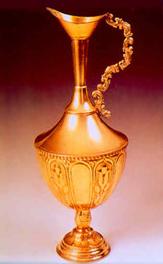
Incense 30:34-38
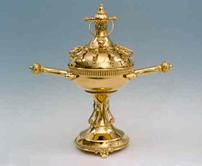
Construct Except on the Sabbath (Ex 31)
Artisans for Building the Tabernacle 31:1-11
31:1 ![]() Who is speaking? To whom? Still the Lord to Moses. Repeating the speaker here is indicative of a change of subject, now we are moving to the artisans who will construct the tabernacle.
Who is speaking? To whom? Still the Lord to Moses. Repeating the speaker here is indicative of a change of subject, now we are moving to the artisans who will construct the tabernacle.
31:2 ![]() Who has God called by his name? Bezalel.
Who has God called by his name? Bezalel. ![]() What do we learn of him? He of son of Uri, Grandson/descendant of Hur, and of the tribe of Judah. Who was Hur? Why would he have been mentioned? Hur played a couple noteworthy roles: “There appears to be sufficient reason for identifying Hur, the grandfather of Bezaleel, with the Hur who assisted Aaron in supporting the hands of Moses during the battle with Amalek at Rephidim Ex. 17:10, and who was associated with Aaron in the charge of the people while Moses was on the mountain Ex. 24:14.” (Barnes)
What do we learn of him? He of son of Uri, Grandson/descendant of Hur, and of the tribe of Judah. Who was Hur? Why would he have been mentioned? Hur played a couple noteworthy roles: “There appears to be sufficient reason for identifying Hur, the grandfather of Bezaleel, with the Hur who assisted Aaron in supporting the hands of Moses during the battle with Amalek at Rephidim Ex. 17:10, and who was associated with Aaron in the charge of the people while Moses was on the mountain Ex. 24:14.” (Barnes)
31:3 ![]() How has God prepared Bezalel? God gave him the Spirit of God in wisdom, understanding, and knowledge, and in all kinds of craftsmanship.
How has God prepared Bezalel? God gave him the Spirit of God in wisdom, understanding, and knowledge, and in all kinds of craftsmanship. ![]() What is important about having wisdom, understanding, and knowledge? he has the knowledge and discernment necessary to carry out God’s instructions the way God intended.
What is important about having wisdom, understanding, and knowledge? he has the knowledge and discernment necessary to carry out God’s instructions the way God intended.
“God supernaturally enabled Bezalel to do the work of building the Tabernacle. God saw this work as just as spiritual, and just as dependent on the Holy Spirit’s power, as the work Moses and Aaron did.” (Guzik)
31:4 What was Bezalel to do enabled by the holy spirit? To make artistic or intricate designs in Gold, silver, and bronze, metal-working.
31:5 What else was Bezalel to do? Cutting gem-stones to be placed in settings, and carving wood, other types of craftsmanship. What might other types of craftsmanship have encompassed in this context? Based on the things used to construct th tabernacle, spinning, weaving, embroidery, dying things colors, compounding perfumes, etc. might have been needed?
31:6 Who else did God appoint? Oholiab. What details are we told about him? Son of Ahisamach, tribe of Dan. What did God apppoint Oholiab to do? Assisting bezalel. Was anyone else called? The passage implies so, but doesn’t name the individuals by name, “in the hearts of all who are skillful I have put skill”. What would the skill God placed in these artisans enable them to do? Make all that God commanded for the tabernacle.
“Even as God specifically chose Moses and Aaron, He also specifically chose these craftsmen for His service.” (Guzik)
31:7-11 What were the craftsmen to make? The tent of meeting, ark of the testimony & its mercy seat, the furniture of the tent, a table & its utinsels, a lampstand and utinsels, altar of incense, a second altar for burnt offerings and its utinsels, the laver/washbasin, woven garments, holy garments for the high priest and his sons, annointing oil, incense. All the things needed for the tabernacle. This appears to be a fairly specific inventory of the items needed for the tabernacle.
31:10 What kinds of clothes were they to make? (1) Woven garments – The colorful richly adorned robes for the high priest (2) holy garments for Aaron the high priest, the holy garments made of white linen for day of atonement (3) garments for Aaron’s sons, aka, white linen garments for all the priests for their normal duties.
The Sabbath Law 31:12-18
31:12 ![]() Who is speaking? To Whom? God to Moses, same as the previous paragraph.
Who is speaking? To Whom? God to Moses, same as the previous paragraph.
31:13 This verse begins with “But as for you”, why? This transition indicated a change here from how it was previously talking about what the artisans would to to what God is to have Moses instruct the sons of Isreal to do. ![]() What is Moses to say? Observe the sabbath.
What is Moses to say? Observe the sabbath. ![]() To whom? The sons of Isreal.
To whom? The sons of Isreal. ![]() Why were the sons of Isreal instructed to keep the sabbath? As a sign.
Why were the sons of Isreal instructed to keep the sabbath? As a sign. ![]() What is the effect of the sign? that they may know the Lord sanctifies them
What is the effect of the sign? that they may know the Lord sanctifies them
![]() Application (from the Life Application Study Bible Notes): “The Sabbath had two purposes: It was a time to rest and a time to remember what God had done. […] God reminds us that without Sabbaths we will forget the purpose for all of our activity and lose the balance crucial to a faithful life. Make sure your Sabbath provides a time of both refreshment and remembrance of God.”
Application (from the Life Application Study Bible Notes): “The Sabbath had two purposes: It was a time to rest and a time to remember what God had done. […] God reminds us that without Sabbaths we will forget the purpose for all of our activity and lose the balance crucial to a faithful life. Make sure your Sabbath provides a time of both refreshment and remembrance of God.”
31:14 ![]() This verse begins with therefore, what is the cause and effect? Cause: Observing the sabbath will cause them to know the Lord sanctifies them. Effect: Observe the sabbath, treat it as holy.
This verse begins with therefore, what is the cause and effect? Cause: Observing the sabbath will cause them to know the Lord sanctifies them. Effect: Observe the sabbath, treat it as holy. ![]() What were the consequences if they fail to keep the sabbath? Death, being cut off from his people.
What were the consequences if they fail to keep the sabbath? Death, being cut off from his people. ![]() Is this a serious concequence or minor concequence? Seems pretty serious. God doesn’t seem to be joking around here about obeying it.
Is this a serious concequence or minor concequence? Seems pretty serious. God doesn’t seem to be joking around here about obeying it.
31:15 ![]() What is repeated here from the previous verse? The negative effects of not following the sabbath.
What is repeated here from the previous verse? The negative effects of not following the sabbath. ![]() Why is it repeated? Perhaps to emphasize the point that this is important. Important things are repeated in the bible.
Why is it repeated? Perhaps to emphasize the point that this is important. Important things are repeated in the bible. ![]() How frequently should the sabbath be observed? Once a week, every seventh day.
How frequently should the sabbath be observed? Once a week, every seventh day. ![]() What else do we learn about how to observe the sabbath? All work must be done in the six other days per week, the sabbath must be a complete rest. How is the sabbath described? 1) A complete rest.
What else do we learn about how to observe the sabbath? All work must be done in the six other days per week, the sabbath must be a complete rest. How is the sabbath described? 1) A complete rest. ![]() Partial rest or half-hearted effort to observe the sabbath isn’t enough, must fully embrace rest. 2) Holy to the Lord.
Partial rest or half-hearted effort to observe the sabbath isn’t enough, must fully embrace rest. 2) Holy to the Lord. ![]() “separated from other days, and entirely devoted to the worship and service of God, and to be kept holy to the Lord in all holy and religious exercises, as hearing and reading the word, praying, praising, etc.” (Gill)
“separated from other days, and entirely devoted to the worship and service of God, and to be kept holy to the Lord in all holy and religious exercises, as hearing and reading the word, praying, praising, etc.” (Gill)
31:16 Who was to observe the sabbath? The “children of Isreal”. For how long should they continue to observe the sabbath? Throughout their generations. The covenant was perpetual.
31:17 What parallel is drawn to the sabbath for Isreal? How God created the heavens and the earth in six days, and rested on the seventh day. What was the effect of God’s Sabbath? He stopped working and felt refreshed.
31:18 What did God give Moses? Tablets of the Testimony, stone tablets written by God’s finger. When did he give them to Moses? After he finished speaking to Moses on Mt. Sinai. Who wrote the writing on the tablets? How? God, using his finger. ![]() What is the significance of God’s words being etched in stone? Permanance, something that can be passed on between generations. “We often say that something can be changed because “it’s not written in stone.” These commandments were written in stone.” (Guzik)
What is the significance of God’s words being etched in stone? Permanance, something that can be passed on between generations. “We often say that something can be changed because “it’s not written in stone.” These commandments were written in stone.” (Guzik)
Related verse: 1 cor 3:2-3: “You are our letter, written in our hearts, known and read by all men; being manifested that you are a letter of Christ, cared for by us, written not with ink but with the Spirit of the living God, not on tablets of stone but on tablets of human hearts.“ God writes on our hearts the way he wrote on these tablets.
Go on to Reaction to the Law (Ch 32-40)
